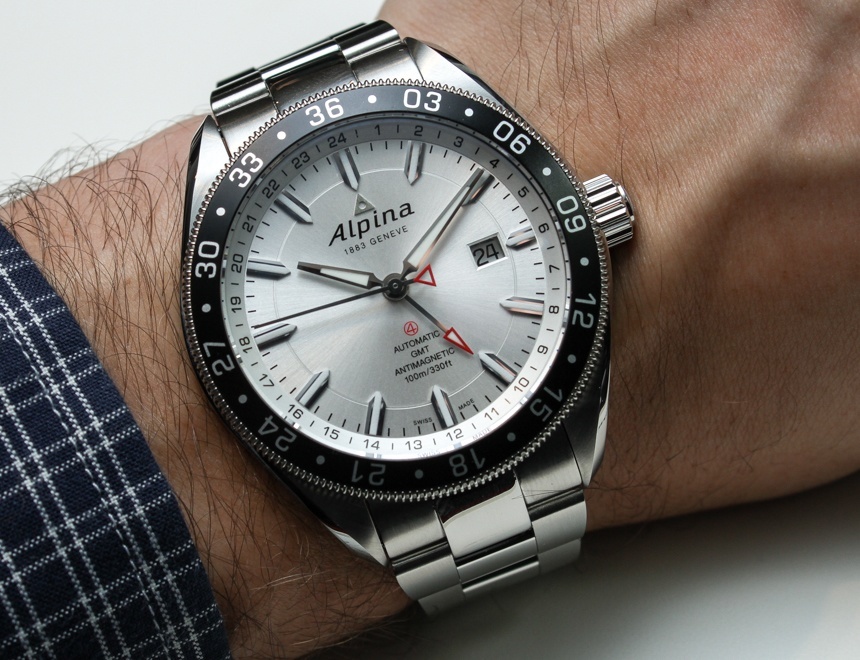
Earlier this year, Alpina announced a new line of watches designed to echo the sporting philosophy of their roots. The new Alpiner collection joins their Startimer (pilot) and Seastrong (diver) lines and draws inspiration from legacy models and the brand’s rekindled relationship with Alpinist lifestyles. Within the Alpiner collection there is a sportier subset consisting of a chronograph and a GMT, collectively known as the “Alpiner 4.” The “4” title is in reference to what Alpina believes are the four essential elements of a sports watch – anti-magnetic, anti-shock, water-resistance and stainless steel. With a modern and well proportioned design along with a sports watch ideology and Alpina’s expertise in producing a high-quality yet accessible watch, the Alpina Alpiner GMT 4 is deserving of a closer look.
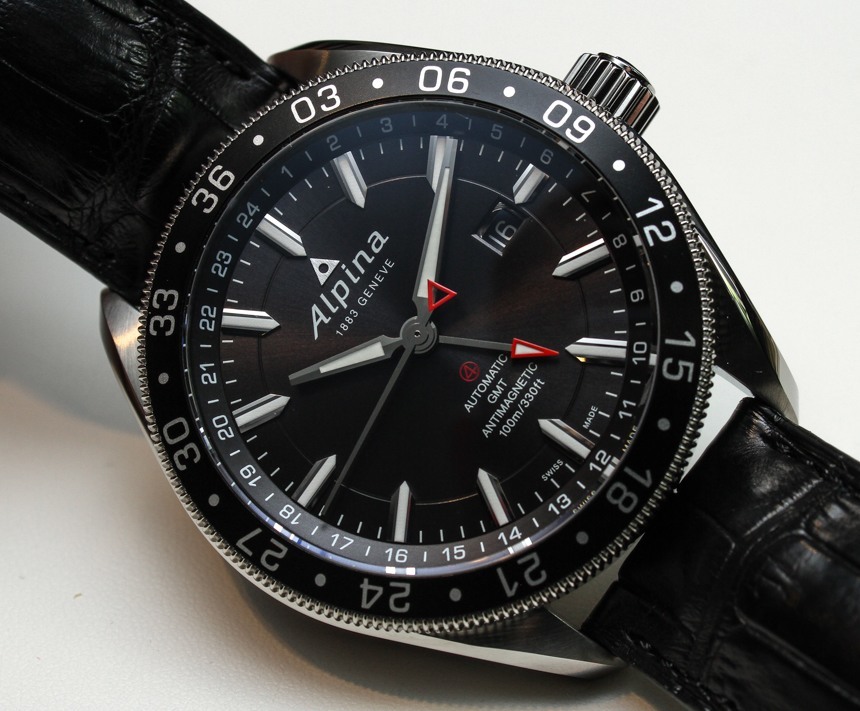
While both the Chronograph 4 and the GMT 4 look great, I find a GMT to be a more interesting complication, especially when properly tuned for travel. There are a number of ways that a brand might attempt to implement a second timezone complication. For my wrist, a true GMT watch should be able to quickly, easily, and accurately change the time display to reflect local time while preserving some indication of home time and preferably AM/PM at home (so you’re not calling friends or family when they’re asleep). This is the methodology reflected by the Rolex GMT-Master II, which allows the user to advance the main hours hand in one hour “jumps,” without stopping the seconds hand. So when you land in a new time zone, you can quickly update to the correct time without compromising the accuracy of the minutes or seconds display.
We saw dozens of “GMT” watches at Baselworld and many have the feature backwards. The primary time display is adjusted much like any three-hander while an independent hand can be adjusted to track a second timezone, generally via a 24 hour display to aid in day/night approximations. This feature is handy if you need to know the time in a second time zone for your day-to-day business but aren’t necessarily travelling between time zones.
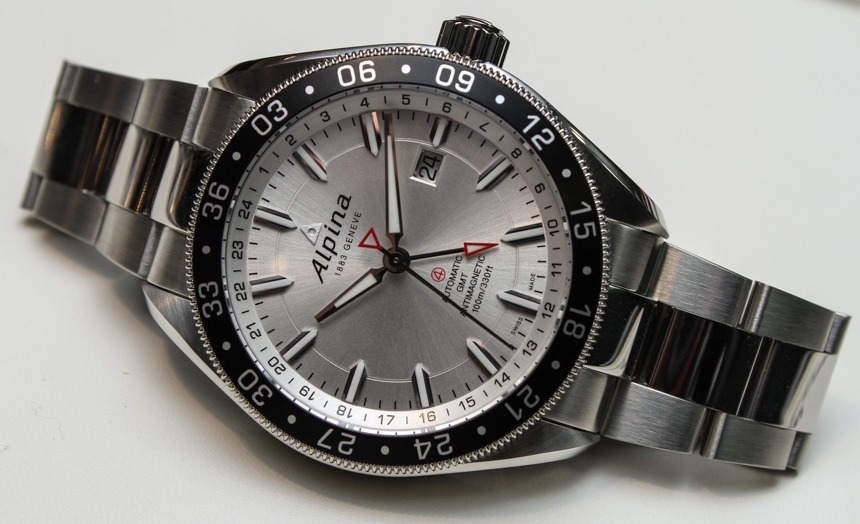
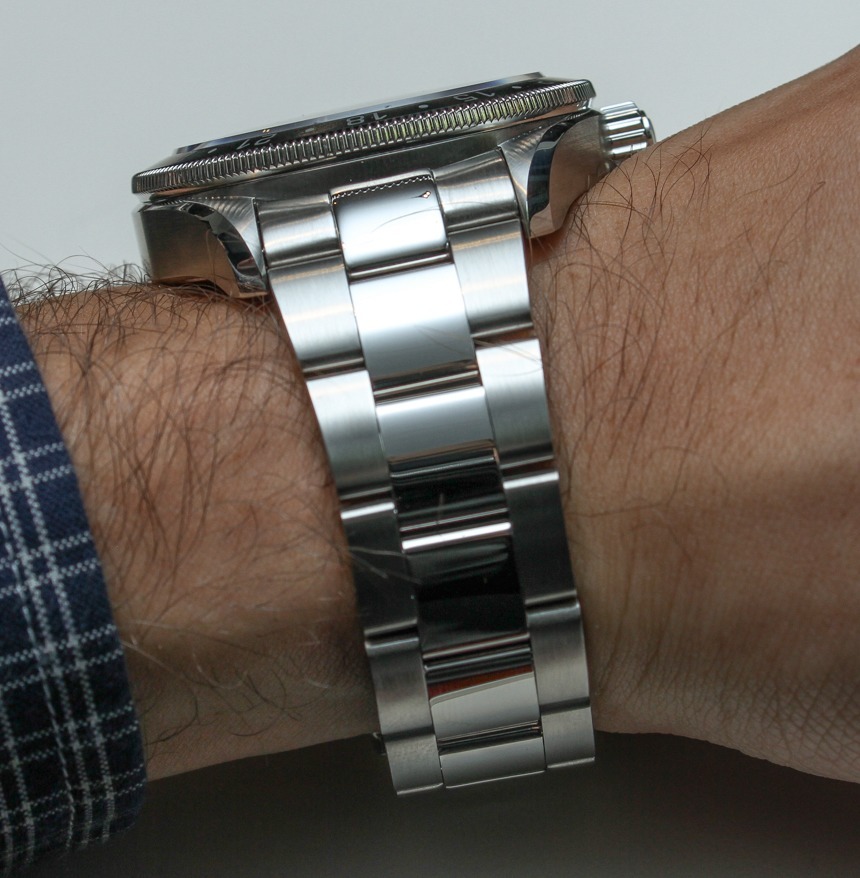
This setup, sometimes called twin time or simply dual time zones, is less useful when traveling, as you have to essentially reset the entire watch when you land, often requiring a local time display (or time as relayed, often incorrectly, by the flight crew) to ensure the accuracy of the setting. Once set, a second time zone-style GMT will give you the same information, it’s just not tailored for travelling.
The Alpina Alpiner GMT 4 employs a Sellita SW 200 automatic movement with a custom module, allowing for jumping local hour hand functionality. Not only is this setup more functional for travel, its increased cost and complexity suggests that Alpina wanted to make the best possible GMT watch, not simply a “GMT” that can track two time zones. Though it is likely that the Chronograph 4 will be the more popular of the two, the GMT 4 offers a lot for its price tag while maintaining the easy appeal of a three-hander.
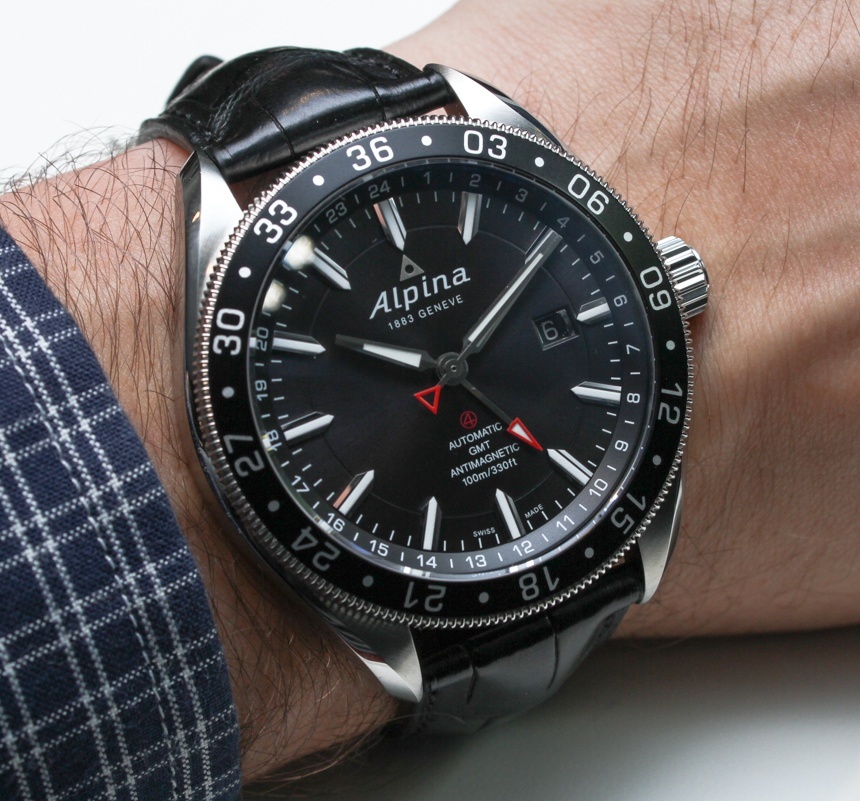
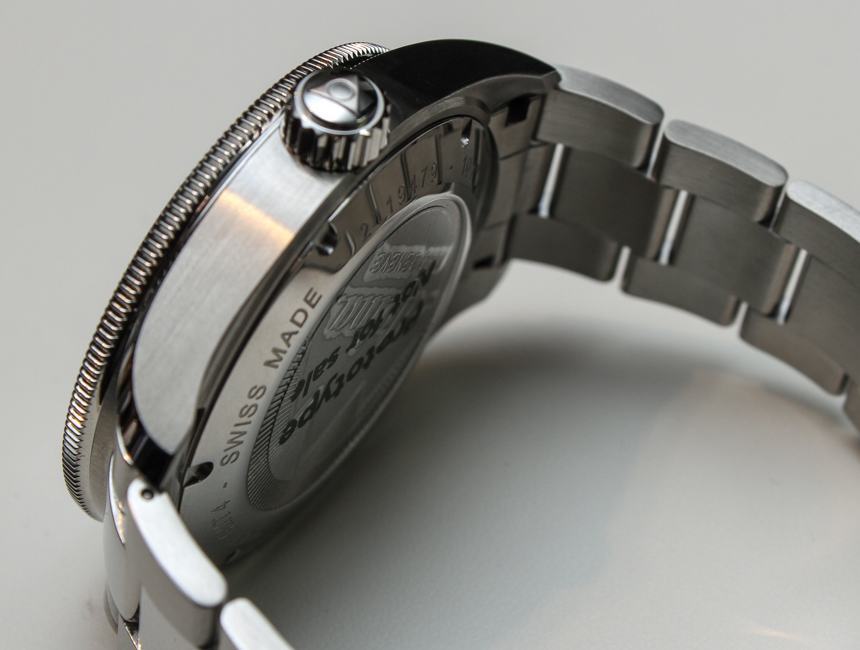
With a 44mm wide stainless steel case and 22mm lugs that host either a leather strap or a three-link steel bracelet, the Alpina Alpiner GMT 4 is a modern sports watch with a significant feel and weight on the wrist. Available with either a black or a silver dial, both models are fitted with a bi-directional 360-degree navigation bezel that caused many a quizzical second glances when we first saw the watch at Baselworld earlier this year. The crystal is sapphire, and the case back is solid to protect the anti-magnetic properties of the GMT 4’s design, rated to ISO 764 (4800 A/m). The GMT 4 is also shock resistant to ISO 1413, and the dial design is legible and detailed with a small 24-hour scale on the chapter ring, a date display at three, and some simple red accenting that is common across the entire Alpiner collection.
The case features mixed finishing with polished edging on the lugs that is nicely executed for a watch at this price point. While I would prefer a simple 24-hour bezel for tracking a third timezone or aiding in AM/PM indication, the 360 degree navigation bezel fits nicely with the alpinist lifestyle to which Alpina is connected. For those who haven’t recently picked through their website, Alpina is quite active in the pursuit of exploration and mountaineering. Not only does Alpina organize adventure trips for the public through their Alpina Adventurers program, the trips are lead by explorer and all-around badass, Børge Ousland (if you google that name, prepare to feel lazy).
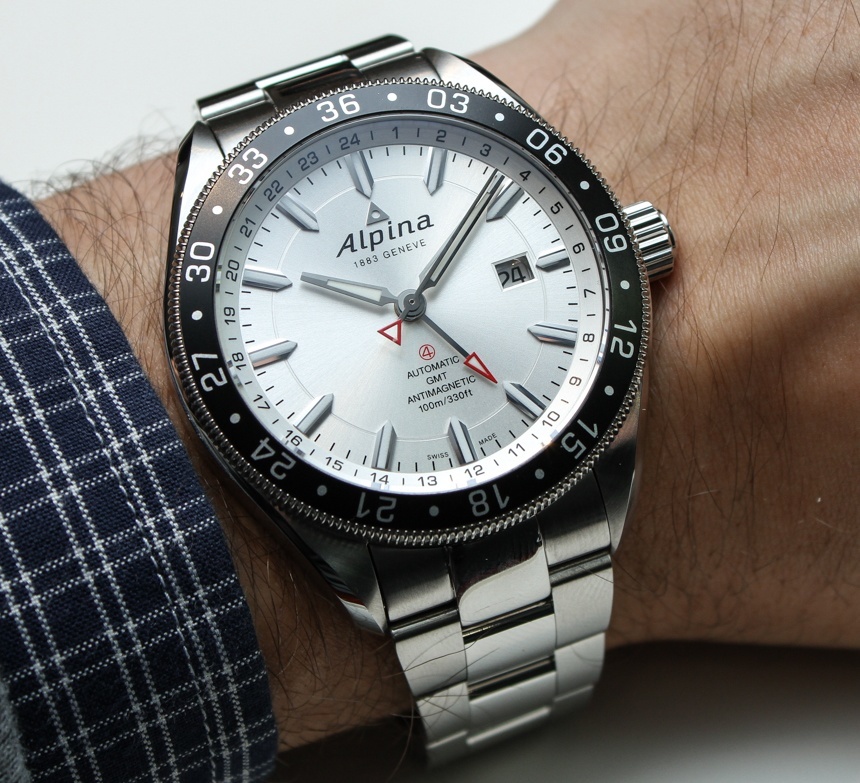
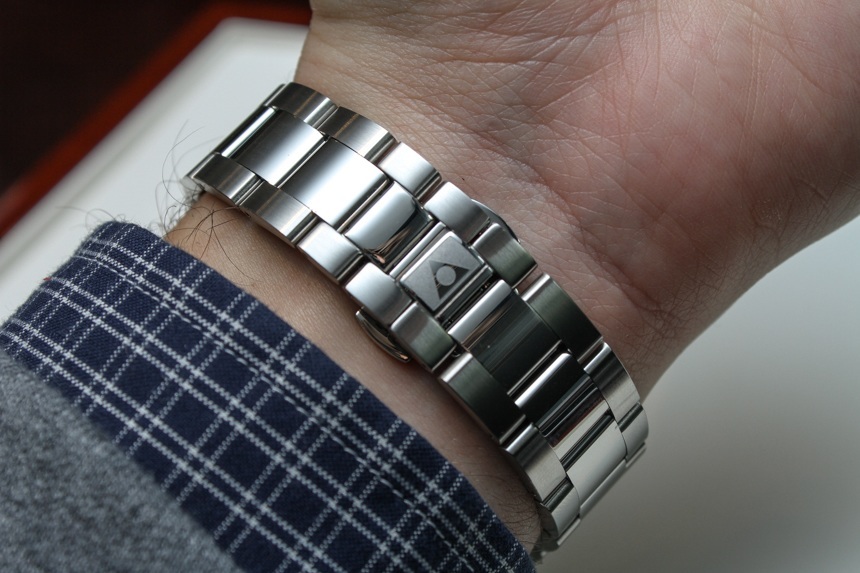
For those wanting to cut their own path into the mountains, Alpina has partnered with the sports activities app ALLTRAILS for the Alpina 4 Summits World Challenge. The premise is simple enough, there are four elevation challenges (based on the elevations of four famed mountain peaks) and you use the app to track your personal net elevation gain as you hike or climb during the span of two months. With enough hiking and climbing you will meet the challenge’s target elevation, at which point you will qualify for a random draw to take part in an excursion to one of the four challenge summits – Matterhorn, Kilimanjaro, McKinley and Everest. Additionally, the three users who achieve the highest net elevation will win an Alpiner watch. Each challenge lasts two months, with the first closing at the end of June. If you love hiking and climbing, click here for more the details.
The Alpina Alpiner GMT 4 is a solid execution of a true travellers GMT watch, all for $2,495 USD. I like the modern styling, with its tough but luxurious vibe and everyday wearability. Whether on the leather strap, the bracelet, or – let’s face it, a nato – the GMT 4 is one of those multi-role watches that can do the office all week and the trail all weekend. alpina-watches.com
